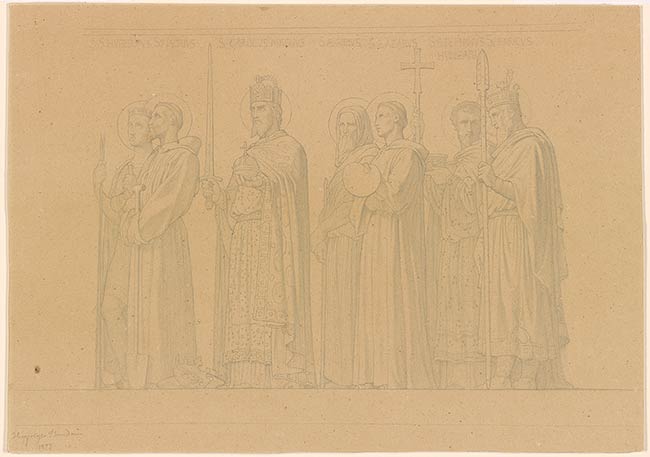
Hippolyte Flandrin, along with his brother Paul, was among the pupils of Ingres who achieved a measure of success. After winning the Prix de Rome, he developed a specialty in religious scenes while in Italy, and upon his return to France began receiving more commissions for decorative schemes than he could manage. His style was shaped by Raphael and the Italian masters he studied while abroad, which allowed him to adapt the manner associated with Ingres to the taste of a new generation.
Flandrin's success meant that he declined some commissions, including the initial one to decorate the church of St. Vincent-de-Paul, a project on which Ingres was briefly engaged. Eventually, he accepted responsibility for decorating the nave while his fellow pupil from Ingres workshop, François Edouard Picot, adorned the choir. Flandrin began work on the project in 1849, completing the nave decorations in 1853.
This study dates to 1855, when the artist designed a vast number of figures for the nave frieze on the right wall. These seven saints appear in the segment devoted to the Confessors: St. Hubert, St. Fiacre, St. Charlemagne, St. Gilles, St. Lazare, St. Etienne of Hungary, St. Henri. The frieze measures 39 meters long and is 2.7 meters in height. Flandrin approached the challenge by designing a procession of figures on each side of the nave. One side contains confessors, church doctors, martyred saints, and apostles, while the other features penitents, virgin saints, and martyrs. The figures appear against a gold background, recalling medieval mosaics.
Signed and dated, at lower left, "Hippolyte Flandrin / 1855"; inscribed above saints, "S. HVBERTVS. S. FIACRIVS. S. CAROLVS MAGNVS. S. AEGIDIVS. S. LAZARVS. S. STEPHANVS. S. HENRICVS HVNGARI".
Libon, M. M., former owner.
Thayer, John M. (John MacLane), 1944-2004, donor.
